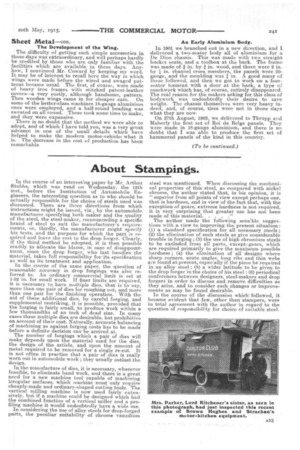About Stampings.
Page 19

If you've noticed an error in this article please click here to report it so we can fix it.
• In the course of an interestjng paper by Mr. Arthur Stubbs, which was read on Wednesday, the 12th in st., before the Institution of Automobile Engineers, the interesting question as to who should be actually responsible for the choice of steels used was discussed. There are three directions from which instructions might be issued, viz., by the automobile manufacturer specifying both maker and the quality of the steel, the steel-maker, recommending a specific brand of steel to suit the manufacturer's requirements, or, thirdly, the manufacturer might specify his tests, and the purpose for which the part is required and leave the rest to the drop forger. Clearly, if the third method be adopted, it is then possible readily to allocate the blame, in case of disappointment, since the drop forger, who last handles the material, takes full responsibility for its specification as well as its treatment and application. In the course of the same paper, the question of reasonable accuracy in drop forgings was also referred to. An ordinary commercial limit is set at 1-32 in. for small work. If finer limits are required, it is necessary to have multiple dies, that is to -say, more than one pair of dies for roughing out, and more than one pair for the finishing operation. With the aid of these additional dies, by careful forging, and supplemental restriking, it is possible, provided that the forging is fairly small, to produce work within a few thousandths of an inch of dead size. In many cases these multiple dies are desirable, but prohibitive on account of their cost. Naturally, accurate balancing of machining as against forging costs has to be made before a definite decision can' be arrived at. The number of forgings which a pair a dies will make depends upon the material used for the dies, the design of the article, and upon the amount of metal required to be removed for a single re-cut. It is not often in practice that a pair of dies is really worn out in automobile work ; they usually outlast the design.
In the manufacture of dies, it is necessary, wherever feasible, to eliminate hand work, and there is a Feat need for a new machine tool capable of machining irregular surfaces, which machine must only require cheaply-made and ordinary-shaped cutting tools. The vertical milling machine is now used fairly extensively, but if a machine could be designed which had the combined function of a vertical miller and a profiling machine it would undoubtedly have a wide use. In considering the use of alloy steels for drop-forged parts, the peculiar suitability of chrome vanadium
steel was mentioned. When discussing the mechanical properties of this steel, as compared with nickel chrome, the author stated that, in his opinion, it is "superior from all points of view except perhaps one, that is hardness, and in view of the, fact that, with the exception of gears, extreme hardness is not required, it is very surprising that greater use has not been made of this material. . . ."
The author made the following sensible suggestions with a view to improving the present situation: (1) a standard specification for all necessary steels ; (2) the elimination of such steels as give considerable trouble in forging; (3) the use of high chromium steels to be excluded from all parts, except, gears, which axe required primarily to give the maximum possible hardness ; (4) the elimination of all designs where sharp corners, acute angles, long ribs and thin webs are found at present, especially if the piece be required in an alloy steel ; (5) a wider latitude to be given to the drop forger in the choice of his steel (6) periodical conferences between designers, steel-makers and drop forgers in order to discuss and remove difficulties as they arise, and to consider such changes or improvements as may be found desirable. In the course of the discussion which followed, it became evident that few, other than stampers, were in total agreement with the author in regard to the question of responsibility for choice of suitable steel.






















